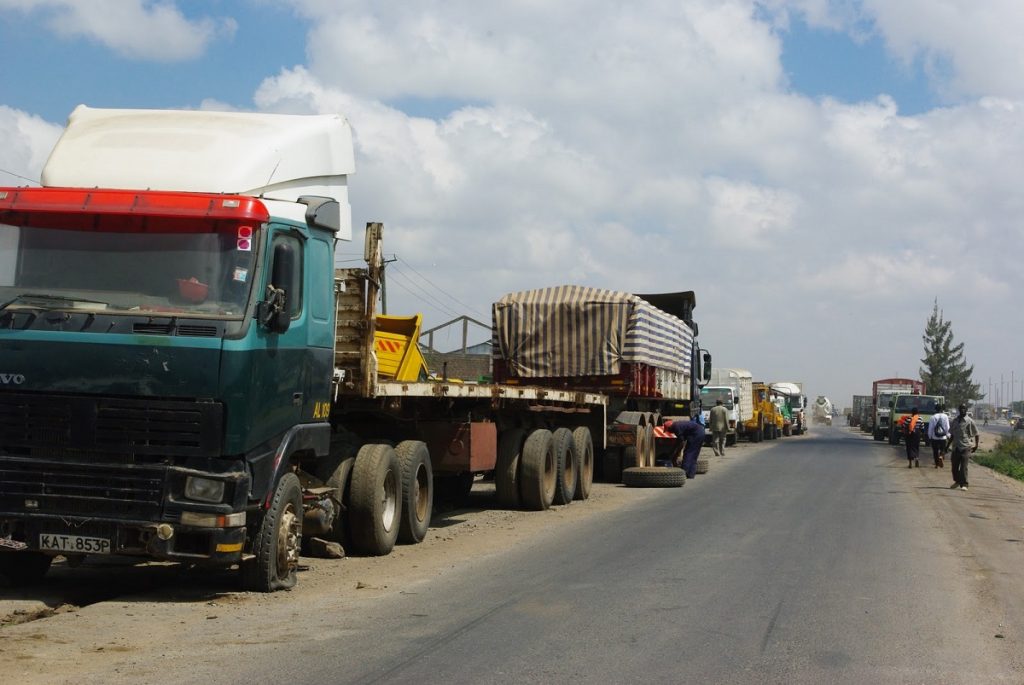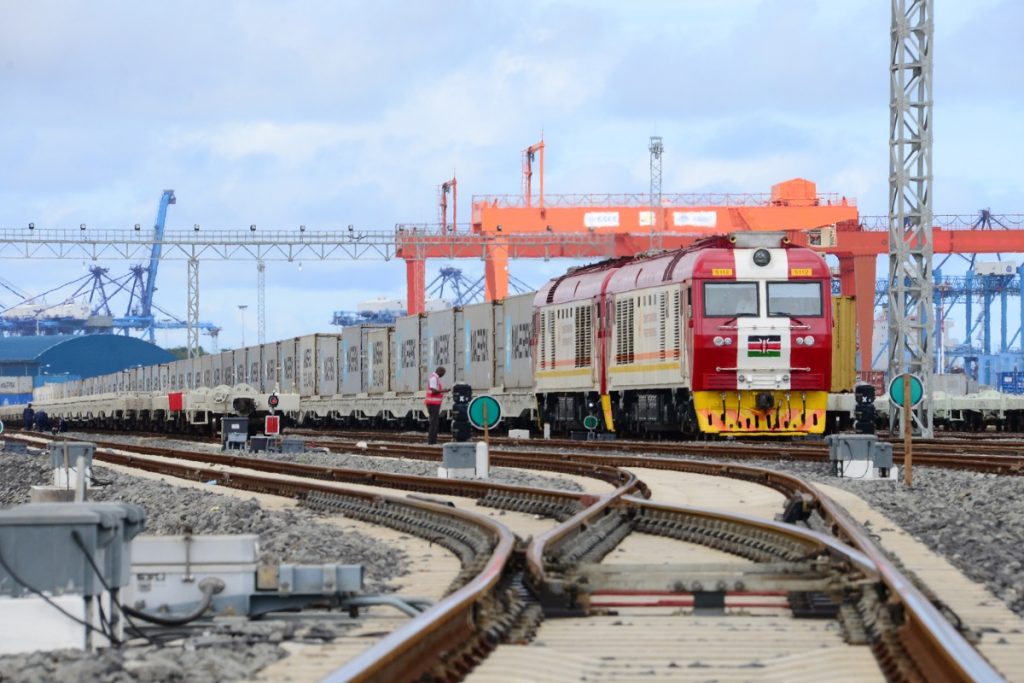Business News
Slow and Painful Death of Mombasa’s Port Economy
Published
6 years agoon
[ad_1]
The Transport Cabinet Secretary James Macharia has snubbed Senate Committee on Roads and Transport on three occasions now, failing to respond to why the government has not revoked the notice that directed all Nairobi bound imported cargo to be evacuated through the Standard Gauge Railway (SGR).
Interior Cabinet Secretary
Dr Fred Matiang’i and Mr Macharia had agreed to lift the order in a meeting
with stakeholders on the eve of the Heroes Day or Mashujaa Day celebration on
20th October, an event Mombasa residents had threatened to protest
due to the heavy toll the directive has had on the Mombasa economy, which is
largely logistics driven.
Local traders and truck haulers have over two months now been holding weekly protests. The directive has brought a lot of strain on Mombasa’s economy and small towns along the Northern Corridor that heavily relied on heavy commercial trucks.
Jobs on the line
Before the SGR
started cargo freight, trucks were evacuating over 1,200 containers every day
from Container Freight Stations (CFSs) in over 800 trucks. CFS operators are
now only allowed to handle Mombasa bound cargo, which is less than 10% of the
total Mombasa port volumes.
This has led to
massive layoffs by the CFS operators and truckers. Maritime Business and
Economic Consultants, in a study of the future of the CFS in the wake of the
SGR done in 2017 found out that CFSs employed 1,804 employees, raking a monthly
salary of Ksh102 million.
“Out of this
number, 1,276 are permanent staff and 528 contracted staff,” the study led by
Mr Gichiri Ndua, an economist and former Kenya Ports Authority (KPA) managing
director said.
At any given
time, there were over 500 casual staff mainly involved in container cleaning,
transfer of vehicles from port to CFSs and general labour used for stripping,
the report observed.
The permanent capacity constraint of the SGR against the impressive growth in the cargo volumes through the port of Mombasa have led experts to question the rationale behind the government to vanquish road transport, which will come in handy when the railway and road will be expected to co-exist smoothly in the next few years.

“Over the
next few years, as cargo throughput increases and the SGR becomes more
efficient, the two modelw will co-exist and therefore share on 40:60 at best
for rail and road respectively,” according to the Ndua study.
Mombasa Port container traffic has been recording an average growth of 10% in the last decade and the facility recently handled over 32 million tons a year. The feasibility study carried out by the China Road and Bridge Construction (CRBC) on SGR in 2011 projected that the port will handle 41 million tonnes of cargo by 2028.
SEE ALSO >> Kenyans Can’t Eat a Dying Economy, GDP Growth Figures and the SGR Mess
Kenya Institute
of Public Policy Research and Analysis (KIPPRA), a government policy think
tank, has put the operational capacity of the railway in terms of the rolling
stock already acquired and configuration of the line, at 12 trains daily at
maximum, at 8.7 million tonnes a year. The 2011 feasibility study estimated
that the SGR would handle over 22 million tons.
The Internal
Container Depot (ICD) in Embakasi also has a serious capacity constraint, which
is given at 450,000 TEUs per year. The government has been forced to lease extra
storage area outside the ICD to handle overstayed cargo.
This compares poorly with Mombasa, which has an overwhelming combined capacity of slightly over 2 million TEUs, with CFSs contributing 700,000 TEUs assuming cargo dwell time of 7 days (time between the cargo being received up to the time of evacuation).
Road still has a role to play
SGR is currently
handling Nairobi bound cargo alone. With the extension of the railway line to
Suswa and the planned rehabilitation of the Medium Gauge Railway (MGR) line to
Malaba, it is expected that it will also handle transit cargo to make any
economic sense. With the existing capacity, experts say, the SGR will not be
able to handle both the domestic and transit cargo.
Without expanding
the railway infrastructure, which looks likely in the foreseeable future, the
extra cargo will be only be evacuated through road.
Mombasa Port yard
capacity is highly constrained and cannot survive without support of CFSs. The
reported holding capacity of port at 70% utilization, the recommended rate for
a port to be categorized as not congested, was 22,500 TEUs. The port on average
held 16,000 TEUs in 2017.
This constraint was offset by the CFSs, with a holding capacity of 38,470 TEUs. An average holding of CFSs at any given time was 21,830 TEUs, thus 58 percent capacity utilization.

“What is of more
major concern is that CFSs hold more containers than the port. Indeed, if the
21,830 TEUs were to be dumped in the port, one would not get a place to step in
at the terminal,” Ndua’s report observed.
Although they had
stabilized logistics industry, development of CFSs in the manner they did in
Mombasa was largely unforeseen. The original idea was for the stations to earn
profits by charging demurrages for cargo that was not cleared within the free
storage period, which then stood at 7 days. Therefore, they were to serve as
extension of the port with a mandatory requirement for them to apply KPA
tariff.
Due to the increased cargo volumes over time that was not matched with infrastructural projects development, the port reached a point of rupture in 2007.
The ship
turnaround deteriorated and, for the first time in history, KPA faced a Vessel
Delay Surcharge (VDS), a highly punitive fee the shipping lines levy for
unusual delays, which can go as high as Ksh30 million a day depending on the
size of the vessel or the type of cargo.
The congestion
was so serious that an estimated 60% of the cargo volume through the Port of
Mombasa could not be cleared within the free storage period.
Therefore, for the initial CFS investors, this business model was highly lucrative, although they also became very unpopular due to what importers saw as deliberate delays to earn more profits.
Port becoming competitive?
They proliferated
very fast and in a span of a few years, the number had grown to over 10 CFSs.
The extra capacity they created gave KPA a breathing space to develop more
infrastructural projects-new container terminal, extension and deepening of
berths and dredging of the channel to allow huge vessels.
This, in turn,
increased efficiency at the port and with the CFS business becoming more
competitive, KPA gave importers leeway to nominate cargo to the stations of
their choice.
The huge
infrastructural development at the port and acquisition of modern equipment by
CFS operators meant that the demurrage model could not sustain their
businesses. CFSs investment profile is estimated at over Ksh20 billion.
With no room for
tariff adjustment, CFSs had to innovate to remain afloat. They then introduced
tailor-made arrangements with their customers, largely serving as distributive
points as well as storage areas for the already cargo cleared by the Kenya
Revenue Authority (KRA) by offices they hosted.
Some CFSs allowed cargo to stay in their yards for up to 60 days. The CFSs became so popular among the importers that those with good marketing skills had over 80 percent of the cargo nominated to stations by importers themselves as opposed to the KPA.
READ ALSO >> Hope for More Jobs in Kenya as US Compies Stream in
It is this cargo
that is now finding its way to ICD in Nairobi, which must be cleared within 4
free storage days. This has disrupted a system that had worked well for over a
decade for traders and which is causing importers nightmare with inefficiencies
and high costs.
KPA is inflexible
in allowing containers to stay at the yard after the expiry of free storage
period both at ICD and port yard; putting importers in an awkward position
should there be any disruption along the logistic chain. They are either paying
high storage charges or risk their goods getting auctioned by the taxman
according to laid down procedures.
The grave mistake the country made was to sign the financing contract on the “take or pay’ arrangement. What this meant is that the KPA, on completion of the SGR, was to commit a certain amount of the cargo through SGR to help the government get revenue that would, in turn, pay the Chinese loan.
Loss of logistics business
Interesting, as a
cargo handler, KPA could not guarantee any cargo unless it forced the volumes
through SGR as it is doing today.
The government
has already spent a lot of resources to build good road network around the port
of Mombasa, connecting the container terminal to Mombasa- Nairobi highway
through Dongo Kundu by-pass.
The road network, part of which is still under construction has also created good linkage with CFSs. All this is now likely to be under-used unless the government looks into measures that SGR can coexist with other players, including truckers, who have also lost business.
NEXT >> Kenya’s Hottest Corporate Job? A Tale of 4 CEOs at Kenya Ports Authority

[ad_2]
Source link
Comments
The Kenyan Digest Team

You may like

Betty Bayo’s Mother Seeks DPP Inquest Over Daughter’s Death

Why the Sh323.8 Billion Kenya US Health Agreement Is Raising Data Privacy Questions

Nest Lounge Narok Under Scrutiny as KRG The Don Shooting Incident Triggers Government Silence and Maasai Community Outcry

Nest Lounge Narok Under Scrutiny as KRG The Don Shooting Incident Triggers Government Silence and Maasai Community Outcry

Why the Sh323.8 Billion Kenya US Health Agreement Is Raising Data Privacy Questions

Betty Bayo’s Mother Seeks DPP Inquest Over Daughter’s Death

Ugunja Women Cry Foul After MP Appointments Snub Them Despite Campaign Support

KSh4M Serve! SportyBet Kenya Title Sponsors for Kipchumba Karori Eldoret International Volleyball Tournament

Shadrack Maritim Resurfaces in Uganda After Two-Month Disappearance

Lilian Akinyi Akech: A Trailblazer Redefining Leadership in Ugunja

Homa Bay Deputy Governor Oyugi Magwanga Condemns Alleged Unlawful Locking of His Office After Kasipul By-Election Fallout

South Sudan’s Oil Looters: How Young Elite Gatekeepers Plunder Nation While Citizens Starve

Kenya’s Youth Are Losing Faith in the Ballot, Nyakundi Predicts a National Reset Between 2027 and 2029
Trending
-

 Entertainment1 week ago
Entertainment1 week agoBetty Bayo’s Mother Seeks DPP Inquest Over Daughter’s Death
-

 Business News1 week ago
Business News1 week agoWhy the Sh323.8 Billion Kenya US Health Agreement Is Raising Data Privacy Questions
-

 Business News1 day ago
Business News1 day agoNest Lounge Narok Under Scrutiny as KRG The Don Shooting Incident Triggers Government Silence and Maasai Community Outcry